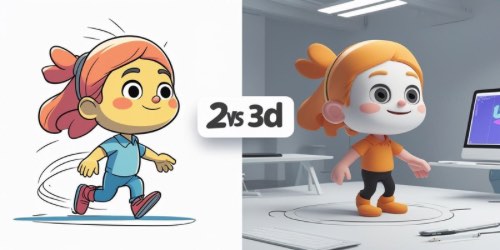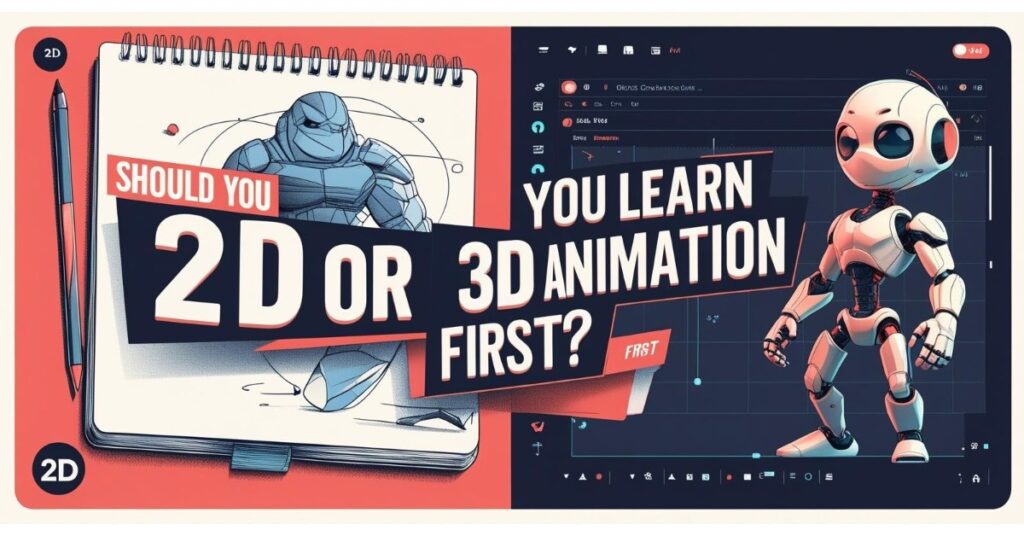The Big Question: 2D or 3D First?
If you’re just starting out in animation, you’ve likely asked yourself this: “Should I learn 2D or 3D animation first?” It’s a common question—and a good one. Both forms of animation offer exciting creative paths, but they demand different skills and tools. The choice isn’t always clear-cut, and the “right” answer depends on your goals, interests, and resources. Let’s break it down to help you decide where to begin.

What’s the Difference Between 2D and 3D Animation?
Before choosing, it’s important to understand what sets these two styles apart:
- 2D Animation is flat and stylized. It involves creating drawings frame by frame (think hand-drawn cartoons or digital vector animations).
- 3D Animation involves sculpting, rigging, and animating models in a 3D space. It looks more realistic and is used in modern films, games, and VFX-heavy projects.
While they’re both rooted in storytelling and movement, they rely on different tools and processes to bring characters and worlds to life. Understanding the demands of each can help narrow your choice.
Why Start with 2D Animation?
Many beginners are encouraged to start with 2D—and for good reason:
- Stronger focus on the fundamentals: 2D animation emphasizes core animation principles like timing, spacing, and squash and stretch.
- Lower learning curve for tools: You can start animating with beginner-friendly apps like FlipaClip or Krita without learning 3D modeling or lighting.
- Affordable or free software: Many 2D tools are accessible to hobbyists with little to no budget.
- Direct connection to drawing: If you enjoy sketching or illustrating, 2D can feel more intuitive and creative.
Starting with 2D animation can build your creative instincts and develop your storytelling skills without overwhelming you with technical complexity.
Why Start with 3D Animation?
But 3D has its own advantages—especially if you’re drawn to certain industries or styles:
- Industry demand: Many studios, especially in film and gaming, hire for 3D animation roles.
- No need to draw: If you struggle with drawing, 3D animation allows you to animate without picking up a pencil.
- Exciting visual possibilities: You can create realistic lighting, camera angles, and effects from the start.
- Professional software access: Tools like Blender are powerful, free, and widely used in the industry.
If you’re excited by technology and enjoy building and manipulating objects in 3D space, you might find 3D more engaging and creatively fulfilling.

How to Choose: Ask Yourself These 3 Questions
Still not sure? Try answering these:
- What kind of animation inspires me? Are you drawn to classic cartoons or Pixar-style 3D films?
- Do I enjoy drawing or design? If so, 2D might feel more natural. If not, 3D tools could be a better fit.
- What’s my goal? If you’re aiming for a job in VFX or gaming, 3D might be the path. If you want to make short films or web animations, 2D could serve you better.
There’s no wrong answer—just the best starting point for your own creative journey. And you can always switch or explore both over time.
[WordPress Featured Image Placeholder]
Final Thoughts
Whether you choose 2D or 3D animation first, the most important step is simply to begin. Don’t wait for the perfect choice—start experimenting, learning, and having fun. Animation is a skill that deepens with practice, and both 2D and 3D will teach you how to bring stories to life. So go with the one that excites you most right now—and let your curiosity take it from there.


























